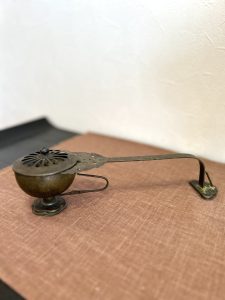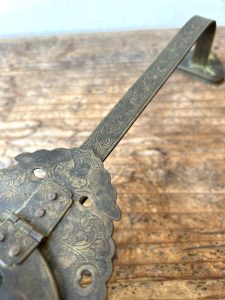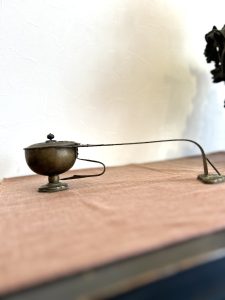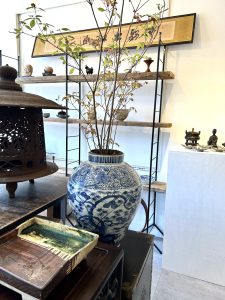スパイスの国から伝わった仏具(愛知県名古屋市千種区姫池通骨董 骨董買取 古美術風光舎)
2023.10.25
皆さまこんにちは。スタッフHでございます。
布団の温もりが心地よくなってきました。季節の変わり目、自分でも気が付かないうちに抵抗力が落ちていたりします。無理をしすぎず、自分を労わることも大切だなと感じております。
さて、先日のブログの続きになります。こちらのお道具は香炉に柄がついた「柄香炉」と呼ばれる仏具で、室町時代のものです。柄香炉は現在も仏具として使われていますので馴染のある方もいらっしゃるのではないでしょうか。

香炉は元々インドで生まれ、中国を経て仏教とともに日本にもたらされたと考えられています。
仏教の起源の地である古代インドには香りを焚く風習が古くからありました。理由としては、インドの気候やスパイスの文化によるようです。一年を通して酷暑の地であり、料理にスパイスを多く使用することから、臭気を防ぐために豊富な香料をブレンドして生成したお香を体に塗抹し、香りをまとう風習があったそうです。その文化が仏教に取り入れられて日本に伝来し、香炉は空間を清める香供養具として重要な仏具に位置付けられました。
柄香炉の柄は真っすぐではなく、末端が下向きに折れ曲がった形をしており、机などに置いた時に安定するようになっています。また一般的な「香炉」は僧、貴族、武士、庶民など幅広い層が使うのに対し、「柄香炉」は基本的には僧しか使用しません。仏具として日本に入ってきた香炉のうち、一般大衆化していったのが据え置きで使う香炉で、仏具として特化されていったのが柄香炉と考えられています。
柄香炉は法要や儀式を行う際、香を焚いて持ち歩き空間を清めるために使用します。持ち方や扱い方には細かな作法が決められており、持ち歩く時は必ず両手を使って持ちます。右手で上から柄の端の曲がっている部分を持ち、左手は下から柄の中央部より少し香炉よりを持つとのことです。
形の種類も様々あり、炉が蓮の花、座が蓮の葉、柄が蓮の茎の形になった「蓮華柄香炉」、柄の末端が三又に分かれてカササギのおの形をした「鵲尾(じゃくび)型柄香炉」、獅子を取り付けた「獅子鎮柄香炉」などがあります。
こちらにある柄香炉は香炉の周囲に蓮の模様が描かれ、座も蓮の葉のようにも見えるので、蓮華柄香炉といえそうですが、形としてはL字型に曲げた柄の端におもりとなる鎮子(ちんず)をつけるようになっているので「瓶鎮(びんちん)柄香炉」ともいえそうです。


瓶鎮柄香炉は太子型柄香炉とも呼ばれ、聖徳太子の名前にちなんでいるようです。少年時代の聖徳太子を描いた絵図や立像は柄香炉を持ったものが多く残されています。私もどこかで目にしていたのでしょうね。
少年期の髪型を結んだ聖徳太子が16歳の時、父である用明天皇の病気が平癒するよう祈願している姿を模した像だそうです。柄香炉の伝来の経緯は定かではありませんが、一説には聖徳太子に仏教の哲学を教えた僧、慧慈法師が用いたものとされています。慧慈法師は朝鮮半島の北部に栄えた高句麗から渡来した僧侶で飛鳥時代前期における仏教文化の中心的存在だったとされています。
こちらの柄香炉も多くの人の手に触れられてきたことでしょう。図々しくも正式な持ち方で、数歩だけ歩いてみました。やはり道具をもつだけではだめですね。日々小さい徳を積む努力をいたします。
それでは、またお会いしましょう。

Hello everyone. This is Staff H.
The warmth of the futon is getting comfortable. As the seasons change, we may find that our resistance is weakening without even realizing it. I feel it is important to take care of myself and not overdo it.
This is a continuation of my blog from the other day. This is a Buddhist ritual utensil called a “patterned censer,” which has a handle attached to the censer, and dates back to the Muromachi period. Some of you may be familiar with the patterned censer, which is still used today as a Buddhist altar utensil.
It is believed that incense burners originally originated in India and were brought to Japan with Buddhism via China.
Ancient India, the place of origin of Buddhism, had a long-standing custom of burning incense. The reason seems to be due to India’s climate and spice culture. Because of the extreme heat throughout the year and the abundant use of spices in cooking, there was a custom of smearing incense, produced by blending a rich variety of fragrances, on the body to prevent the smell of incense. This culture was incorporated into Buddhism and introduced to Japan, and the incense burner was positioned as an important Buddhist utensil as an incense offering to purify the space.
The handle of an incense burner is not straight, but rather bent downward at the end to provide stability when placed on a desk or other surface. While common incense burners are used by a wide range of people, including monks, aristocrats, warriors, and commoners, the patterned incense burners are basically used only by monks. Of the incense burners that came to Japan as Buddhist ritual utensils, it is thought that the stationary incense burner became popular among the general public, while the patterned incense burner was specialized for use as a Buddhist ritual utensil.
Incense burners with handles are used to burn incense and purify the space during memorial services and ceremonies. There are detailed rules on how to hold and handle it, and it should always be held with both hands when carrying it. The right hand holds the curved end of the handle from above, while the left hand holds the handle from below, slightly closer to the center of the censer.
There are a variety of shapes, including the “lotus flower-patterned incense burner,” in which the furnace is shaped like a lotus flower, the seat like a lotus leaf, and the handle like a lotus stem; the “magpie tail-patterned incense burner,” in which the end of the handle is divided into three parts to form a magpie’s head; and the “lion-patterned incense burner,” in which a lion is attached to the end of the handle.
The patterned censer shown here has a lotus pattern around the censer and the seat looks like a lotus leaf, so it could be called a lotus-patterned censer.
The bottle-shaped incense burner is also called a Taishi-type patterned incense burner, named after Shotoku Taishi. Many paintings and standing statues depicting Shotoku Taishi as a boy are still in existence with the patterned incense burner. I must have seen it somewhere too.
The statue is said to be a replica of Prince Shotoku with his boyhood hairstyle tied up, praying for his father, Emperor Yomei, to be cured of his illness when he was 16 years old. It is not known how the patterned incense burner was introduced to Japan, but one theory is that it was used by Master Huija, a monk who taught Prince Shotoku the philosophy of Buddhism. Priest Huija is said to have been a monk who came from Koguryo, which flourished in the northern part of the Korean peninsula, and was a central figure in Buddhist culture during the early Asuka period.
This patterned incense burner must have been touched by many people. I took a few steps in the formal way of holding it. After all, it is not enough just to have a tool. I will strive to accumulate small virtues every day.
I hope to see you again soon.
*******************
ご実家の整理やお片付けなどをされている方のご相談などが多くございます。
お片付けなどくれぐれもご無理のないようになさってくださいませ。
風光舎では古美術品や骨董品の他にも絵画や宝石、趣味のお品など様々なジャンルのものを買受しております。
お片付けをされていて、こういうものでもいいのかしらと迷われているものでも、どうぞお気軽にご相談下さいませ。
また風光舎は、出張買取も強化しております。ご近所はもちろん、愛知県内、岐阜県、三重県その他の県へも出張いたします。
まずは、お電話お待ちしております。
愛知県名古屋市千種区姫池通
骨董 買取【古美術 風光舎 名古屋店】
TEL052(734)8444
10:00-17:00 OPEN
#出張買取#骨董#古美術#骨董品#絵画#版画#茶道具#刀剣#彫刻

